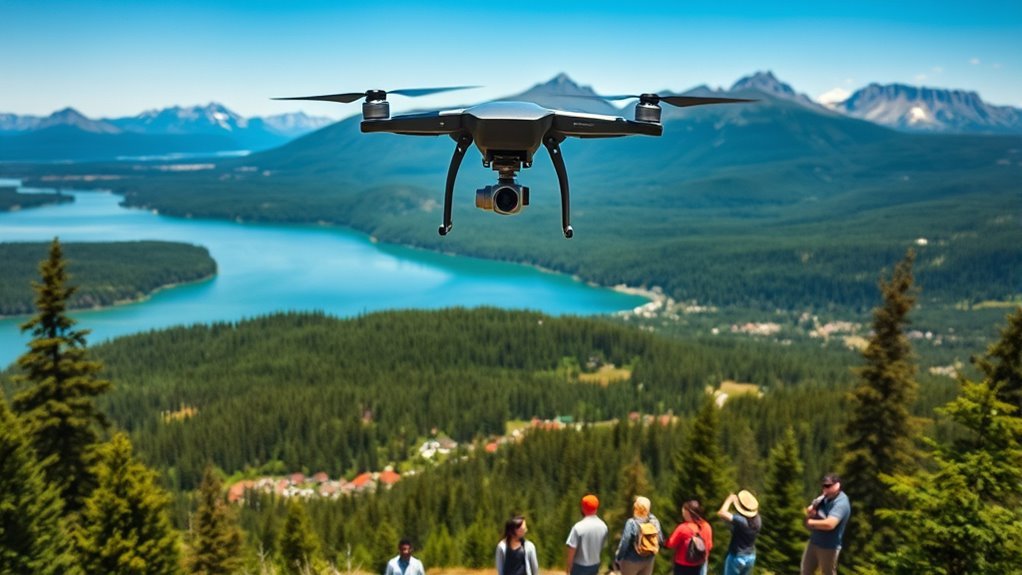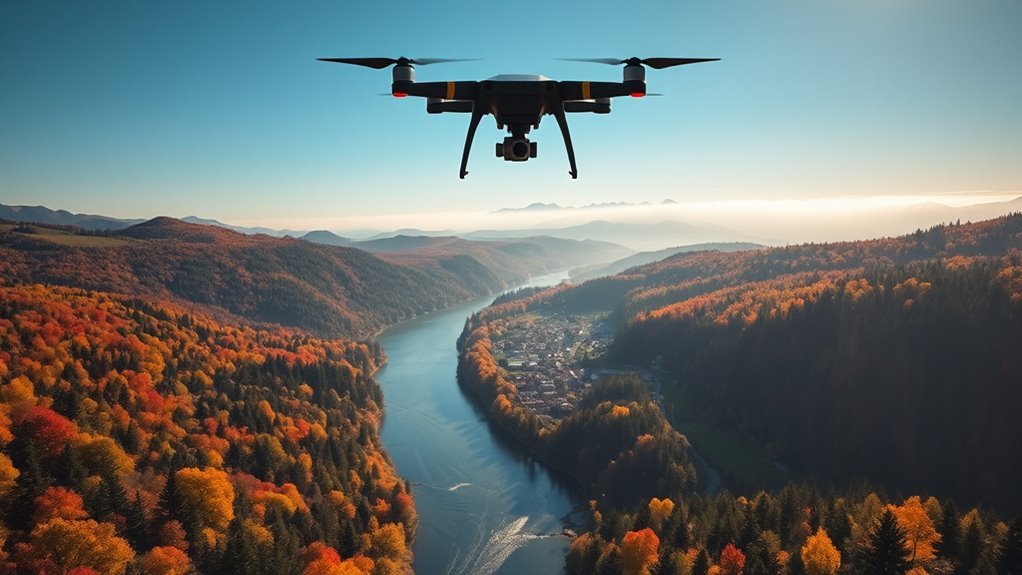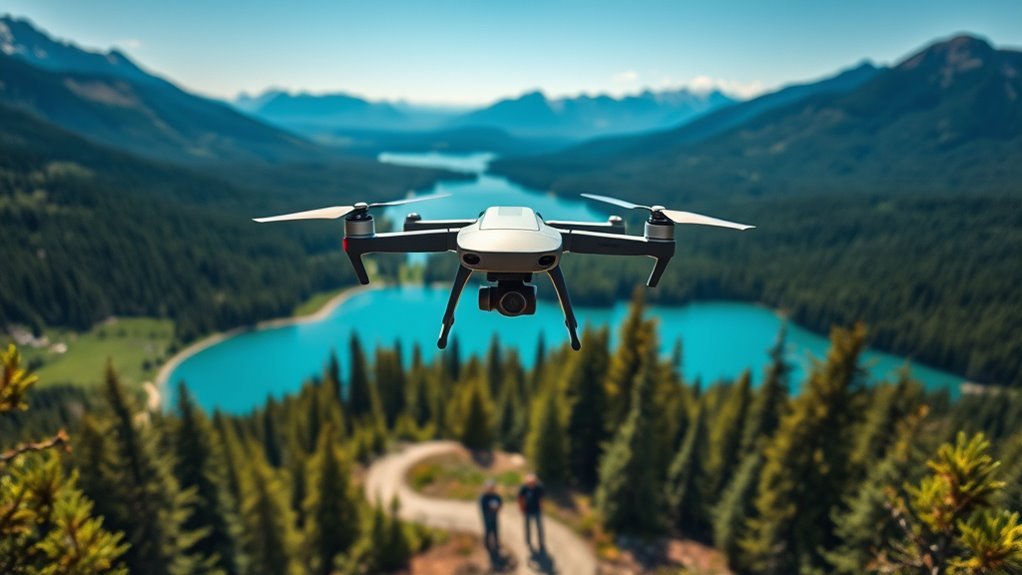In Canada, drone regulations are governed by the Canadian Aviation Regulations (CARs). You must operate within visual line-of-sight and adhere to altitude limits of 122 meters (400 feet). Depending on your operations, you’ll need either a Basic or Advanced Pilot Certificate, which includes a knowledge test on regulations and emergency procedures. It’s critical to stay informed about flight restrictions and no-fly zones. Discovering more about compliance and best practices will enhance your operational safety.
Overview of Canadian Drone Regulations

When you consider flying a drone in Canada, it’s essential to understand the regulatory framework that governs their use. The Canadian Aviation Regulations (CARs) outline specific rules for drone technology, addressing safety, privacy, and airspace management. You’ll need to stay updated on regulatory updates, as these can change based on technological advancements and safety assessments. Key regulations include maintaining visual line-of-sight, avoiding controlled airspaces, and respecting altitude limits. Commercial operators must also adhere to stricter guidelines than recreational users. By familiarizing yourself with these regulations, you can enjoy the freedom of drone flying while ensuring compliance and safety. This knowledge empowers you to navigate the skies responsibly, maximizing your experience while minimizing legal risks.
Required Certifications for Drone Pilots

Understanding the regulatory framework for drone use in Canada also involves knowing the required certifications for drone pilots. To operate a drone legally, you must complete a pilot training program and pass the certification process. This guarantees you’re equipped with the necessary skills to fly safely and responsibly.
- You need to obtain a Basic or Advanced Pilot Certificate, depending on your intended operations.
- A knowledge test is mandatory, covering air regulations, weather, and emergency procedures.
- For advanced operations, a flight review with an accredited examiner is essential.
Flight Restrictions and No-Fly Zones

When operating a drone in Canada, you must be aware of the various flight restrictions and no-fly zones that are in place. These include restricted airspace locations, altitude limitations, and prohibited areas that could impact your flight plans. Understanding these regulations is vital to guarantee compliance and maintain safety in the national airspace.
Restricted Airspace Locations
Although drone technology has advanced rapidly, maneuvering through the complexities of restricted airspace locations is essential for safe and legal operations. Understanding drone geography helps you navigate these limitations effectively.
- Identify no-fly zones, such as near airports, military bases, and emergency response sites.
- Stay informed about temporary flight restrictions, which may arise during special events or emergencies.
- Utilize apps and resources to visualize restricted airspace, ensuring compliance before takeoff.
Navigating restricted airspace requires vigilance and awareness. By knowing where these areas are and the specific regulations that apply, you can exercise your freedom to fly while ensuring safety and legality. Don’t underestimate the significance of this knowledge in your drone operations.
Altitude Limitations
In Canada, drone operators must adhere to strict altitude limitations to guarantee safety and compliance with regulations. You’re typically restricted to a maximum drone altitude of 122 meters (400 feet) above ground level, ensuring airspace safety for manned aircraft. These limitations help maintain a clear vertical separation between drones and other aviation activities, reducing collision risks. Additionally, you should always be aware of local airspace designations, as certain areas may impose lower altitude ceilings or additional restrictions. By respecting these altitude regulations, you not only protect yourself but also contribute to the broader goal of maintaining safe and efficient airspace for everyone. Staying informed about these standards allows you to enjoy your freedom as a drone operator responsibly.
Prohibited Areas Overview
Understanding where you can’t fly your drone is essential for compliance and safety. In Canada, certain prohibited zones enforce airspace restrictions that you must respect to avoid legal ramifications and guarantee public safety. Here are some critical areas to be aware of:
- Near airports: Drones can’t operate within a specified radius of airports to prevent interference with manned aircraft.
- Military installations: Flying over or near military bases is strictly prohibited due to national security concerns.
- National parks and conservation areas: These protected regions often have restrictions to preserve wildlife and natural resources.
Altitude Limits and Airspace Classifications
When operating drones in Canada, it’s vital to be aware of altitude limits and airspace classifications, as these regulations guarantee safe integration into the national airspace system. Drones typically can’t exceed a maximum altitude of 122 meters (400 feet) above ground level unless you’re within a controlled airspace or have special permission. Understanding airspace classifications—ranging from Class A to Class G—is significant for maneuvering safely. For instance, in controlled airspace, specific permissions and altitude restrictions apply, while in uncontrolled airspace, you have more freedom but must still adhere to altitude limits. Knowledge of drone altitude and airspace classification not only guarantees compliance but also enhances safety for you and others in the vicinity.
Insurance and Liability Considerations
While maneuvering through the complexities of drone operations in Canada, it’s crucial to contemplate insurance and liability implications. Understanding the insurance requirements can safeguard your interests and guarantee compliance with regulations. Without adequate liability coverage, you risk significant financial repercussions in case of accidents or damages.
- Assess your operational needs to determine appropriate coverage levels.
- Verify that your insurance meets Transport Canada’s standards.
- Consider additional coverage options for commercial versus recreational use.
Best Practices for Safe Drone Operation
Safety is paramount in drone operation, and adhering to best practices can considerably mitigate risks. To guarantee safe flight, always conduct a thorough pre-flight checklist, including battery checks and system functionality. Familiarize yourself with emergency procedures for quick response in critical situations. Additionally, awareness of restricted zones is crucial to avoid potential penalties during drone operations.
| Checklist Item | Importance | Action Required |
|---|---|---|
| Battery Level | Prevents crashes | Charge fully |
| Firmware Update | Guarantees reliability | Update before flight |
| GPS Signal Check | Navigation safety | Validate connection |
| Propeller Inspection | Avoids malfunctions | Check for damage |
| Flight Area Survey | Safety awareness | Scout for hazards |
Frequently Asked Questions
Can I Fly Drones at Night in Canada?
You can fly drones at night in Canada, but you must comply with night flying regulations. Make certain your drone’s equipped with appropriate lighting requirements, like anti-collision lights, to maintain safety and comply with the law.
Are There Age Restrictions for Drone Pilots?
Yes, there’re age restrictions for drone pilots. You need to be at least 14 for basic operations and 16 for advanced. Familiarize yourself with the drone licensing requirements and pilot certification process to guarantee compliance.
What Happens if I Violate Drone Regulations?
If you violate drone regulations, you’ll face penalties enforced by authorities, potential legal consequences, and restrictions on your flying privileges. Understanding these repercussions is essential to maintaining your freedom as a responsible drone pilot.
How Do I Report a Drone Incident?
To report a drone incident, you should gather details about the situation and contact local authorities or aviation regulators. Prioritizing drone safety guarantees proper incident reporting, helping maintain a safe environment for everyone involved.
Can I Use My Drone for Commercial Purposes?
Sure, you can use your drone commercially, but don’t forget to get drone insurance and obtain the necessary commercial licensing first. Freedom’s great until you realize regulations keep your aerial ambitions grounded.

